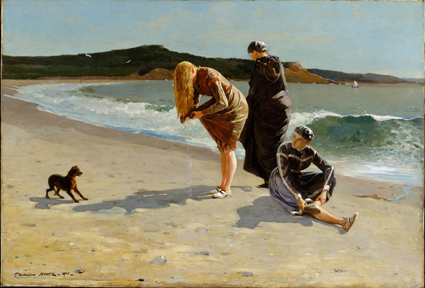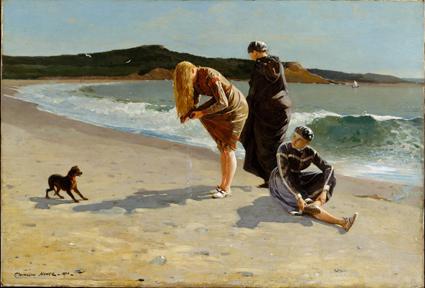Having worked on this exhibition since I first started in the American Art department in 2006, I write with mixed emotions that American Stories: Paintings of Everyday Life, 1765-1915 will finally be coming to a close this weekend. Not only has it been great to see so many of these iconic works in Los Angeles, but every time I go through the exhibition I have the opportunity to take a look and really contemplate the events the artists depicted at the time the work was created. A particular favorite of mine is Winslow Homer’s Eagle Head, Rochester, Massachusetts (1870):

Winslow Homer (American, 1836–1910) "Eagle Head, Manchester, Massachusetts (High Tide)," 1870, The Metropolitan Museum of Art, New York, Gift of Mrs. William F. Milton, 1923, photograph © The Metropolitan Museum of Art
In the foreground Homer depicts three women who have emerged from the shore. Two are depicted with their legs revealed, while the middle figure stands with her back to the viewer. After the Civil War, Winslow Homer’s works that featured women tended to evoke a sentimental quality, and in a sense a throwback to traditional values (if you get a chance to see the show, see Homer’s Croquet Scene (1866) next to Eagle Head).
Yet this work, while depicting three young ladies enjoying a day at the seashore, was reproduced quite differently. You can see the difference in the Brooklyn Museum of Art’s engraving of Homer’s High Tide (1870).
Instead of revealing bare legs, the skirt of the young woman wringing out her dress now shows her garment gathered past her ankles. Also to the left of the canvas, where once a seemingly harmless dog stood with a somewhat inappropriate upward gaze, now lies the young woman’s bathing cap.
Eagle Head, Rochester, Massachusetts is only one of the numerous paintings in American Stories that pose the question of the United States’ transformation to a modern audience. A year before this work was made in 1870, Elizabeth Cady Stanton and Susan B. Anthony formed the National Women Suffrage Association, which would eventually merge in the 1890s with the American Women Suffrage Association. While women would not gain their right to vote until fifty years later, in 1920, this painting and its censored reproduction thus reflected the ongoing issue of women’s rights.
If you do get a chance this weekend to see American Stories, I hope you’ll take a moment to look at the works, and see the depictions and stories of the past events that ultimately developed our nation—stories that even for modern audiences still strike a resonant chord to this day.
While I’m sad to see this exhibition go, I look forward to another exhibition the American Art department has been working on which will open this summer: Manly Pursuits: The Sporting Images of Thomas Eakins.



